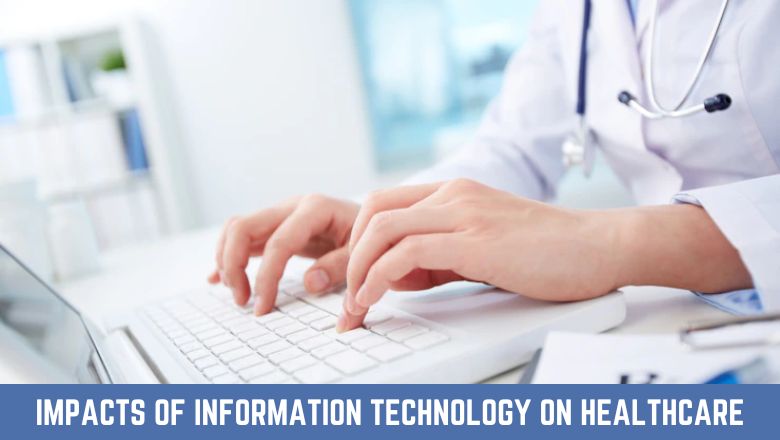In this article, you will get to know all details about the “Impacts of Information Technology in Healthcare“.
- Impacts of Information Technology on the Healthcare Industry:
- FINAL THOUGHT:
The Impacts of Information Technology on Healthcare can never be denied and the impacts of technology in healthcare are truly remarkable.
It is impossible for us to survive without technology. It is evident that technology is revolutionizing almost all fields, including education, health, business, food, and society.
As in other domains, technology plays a significant role in healthcare as well. While the healthcare sector is relatively slow to adopt new technologies, tech health has completely changed the way we think about health.
In the health sector, technology has nearly transformed and rebuilt it, and no doubt brought many positive changes. Health has improved as a result of technology, and it is therefore a primary need of the modern world.
As a result of technology’s numerous contributions to the health sector and the improvement of human welfare, the effects of technology on healthcare are immense and extensive.
Both doctors and patients benefit from the impact of technology on health. The internet allows doctors to stay up-to-date with the latest information.
Patients can also use technology and the internet to learn about conditions, diseases, or any other health problem they are experiencing.
Impacts of Information Technology on the Healthcare Industry:
Healthcare technology continuously strives to improve the quality of human life and save lives.
In the healthcare industry, technology is delivering better health experiences to patients as well as improving the methods by which medical experts carry out patient care using technology.
The purpose of this article is to inform you of the impacts of Information Technology in healthcare as well as the massive improvements that technology has made in the health sector to date.
Remote Patient Monitoring:
Remote Patient Monitoring is abbreviated as RPM. This type of monitoring is also called Remote Health Monitoring, as it aims to improve the quality of life for people and sufferers.
‘Remote’ refers to something that occurs outside of a physical location. Health care services are provided outside the clinical environment or ambiance in remote patient monitoring.
Using the latest and most advanced approaches in the field of technology, remote patient monitoring involves the delivery of healthcare services between the patient and the treating physician.
In the past, remote patient monitoring was uncommon due to which healthcare delivery costs were greatly increased and people were unable to afford it, but thanks to technology, it is now easy and affordable for everyone.
TeleHealth, which is also used for delivering healthcare services, is another term for Remote Patient Monitoring.
Although telehealth is a relatively broader term, it encompasses a variety of telecommunications and new information technology-based healthcare services.
Thanks to telehealth technology, remote patient monitoring has become easy, effective, and practical.
Confidentiality and privacy of data are the highest priorities of RPM. In the statistics, almost seven million people are using telehealth and remote patient monitoring services, and I think the figure is quite impressive for you if you are considering RPM.
Remote Patient Monitoring Devices:
- The device that monitors biosensors.
- Voice Apps.
Wearable Technology in Healthcare:
In the healthcare industry, wearable technology is another great contribution to technology. It is the most convenient and favorable way to monitor and track a patient’s exact health status through wearable technology.
In healthcare, wearable technology refers to small, easy-to-use gadgets that are easy for both patients and physicians to use. Providing real-time results and generating accurate data are two reasons why wearable technology is helpful and important in health care.
An AI medical monitoring device was the first Wearable Medical Technology approved by the FDA. Wearable medical technology allows them to actively contribute to their health’s preservation and maintenance.
Wearable gadgets generate results that are then analyzed by doctors. Doctors make health decisions for patients based on data provided by wearable gadgets.
Most Common Wearable Technology in Healthcare:
- Smart Watches.
- My Skin Track UV.
- Tempura.
- Hearables.
- Smart Glasses.
- Skin Patches.
- Wearable Peritoneal Dialysis Device
Apps in Healthcare:
Everyone around the world has access to healthcare apps that are almost affordable. Our smartphones and tablets are equipped with the latest and most user-friendly apps due to technology.
Using health care apps, we can get better and more convenient health-related services that take less time and are more efficient. Our world has become dependent on it today.
The mobile apps used for health-related services are made by professionals in the IT industry, so you can trust them.
Benefits of Apps in Healthcare:
- Your health can be improved and progressed with these apps.
- It saves you time using healthcare apps.
- As a result of apps, health care is now more easily accessible and can be used by many people at once without losing its authenticity.
- The latest methods and techniques of artificial intelligence can help patients better take care of themselves with healthcare apps.
The Rise of Robotic Surgery in the Healthcare Industry:
In the field of health care, robotic surgery is another major contribution and impact of technology. There are some cases where robotic surgery is preferable, but it is effective and useful for those who prefer it.
In robotic surgery, the surgeon performs a minor amount of dissection on your body. To make sure everything is going correctly, your surgeon inserts a 3D camera into your body.
Robotic surgery offers countless benefits to both doctors and patients. These are some of the advantages that patients and doctors can gain from robotic surgery:
Benefits of Robotic Surgery for Patients:
- One of the best things about robotic surgery is that it is minimally invasive and causes less trauma to the body.
- A patient who undergoes robotic surgery recovers even faster.
- Less pain and less blood loss are experienced by the patient.
- When a patient undergoes robotic surgery, there are usually fewer infections.
- It is easy for a person to return to normal life activities after undergoing robotic surgery.
Benefits of Robotic Surgery for Doctors:
- The mini 3D camera doctors have inserted into the patient’s body makes doctors feel more comfortable and improves their attention and precision toward the patient’s body.
- Because robots work accurately and patients experience less pain and blood loss, doctors feel confident and satisfied.
- Robotic surgery allows doctors to remain relaxed throughout the surgery, allowing them to concentrate fully on what the machine is doing.
Technology is reducing Healthcare Costs:
Technologies are continuously striving to reduce healthcare costs and increase access to improved healthcare services without ever compromising on quality.
As a result of reducing healthcare costs, doctors are able to reach a greater number of patients and provide valuable care to them.
The use of technology can improve health care quality and reduce healthcare costs by finding advanced opportunities and alternatives.
Electronic Medical Records (EMR):
Electronic Medical Records (EMR) are also known as Electronic Health Records (EHR). In the healthcare industry, these are the biggest contributions of technology
The hard-copy medical records of patients have greatly reduced costs and fatigue.
Electronic Medical Records are digitally stored medical and health-related information about people gathered and stored on your smartphones or computers even for a long time.
Electronic Medical or Health records include:
- Health history of the patient.
- Recommendations done by the doctors.
- Treatment plans for patients.
Benefits of Electronic Medical or Health Records:
- EMR is affordable.
- EMR is easy to access.
- Data is reusable.
- Data is secured.
- Old and new results of patients are easy to compare because of EMR.
- Easy maintenance of results obtained by laboratories.
Increased Educational Opportunities for Doctors:
Being aware of the most recent and updated information is crucial in any field. There is even more important when it comes to health care.
With the evolution of technology in healthcare, doctors no longer have to travel anywhere in order to update their knowledge of the health sector.
By using the internet, they can upgrade their knowledge and utilize it where it is most needed.
FINAL THOUGHT:
Taking into account the above-mentioned impacts of technology on healthcare, it is evident that technology has made a significant contribution.
Technology has revolutionized the healthcare industry, simplifying the lives of both doctors and patients and reducing costs efficiently while improving the quality of life and preventing some illnesses and diseases.
You can use the comment section to ask questions about the topic “impacts of information technology in healthcare“. My goal is to respond to your queries as soon as possible.
Please share this article with your family and friends. The impact of technology on different fields, sectors, and industries will be explored in more detail.
So keep up reading and learning with Rehmat Ullah.

